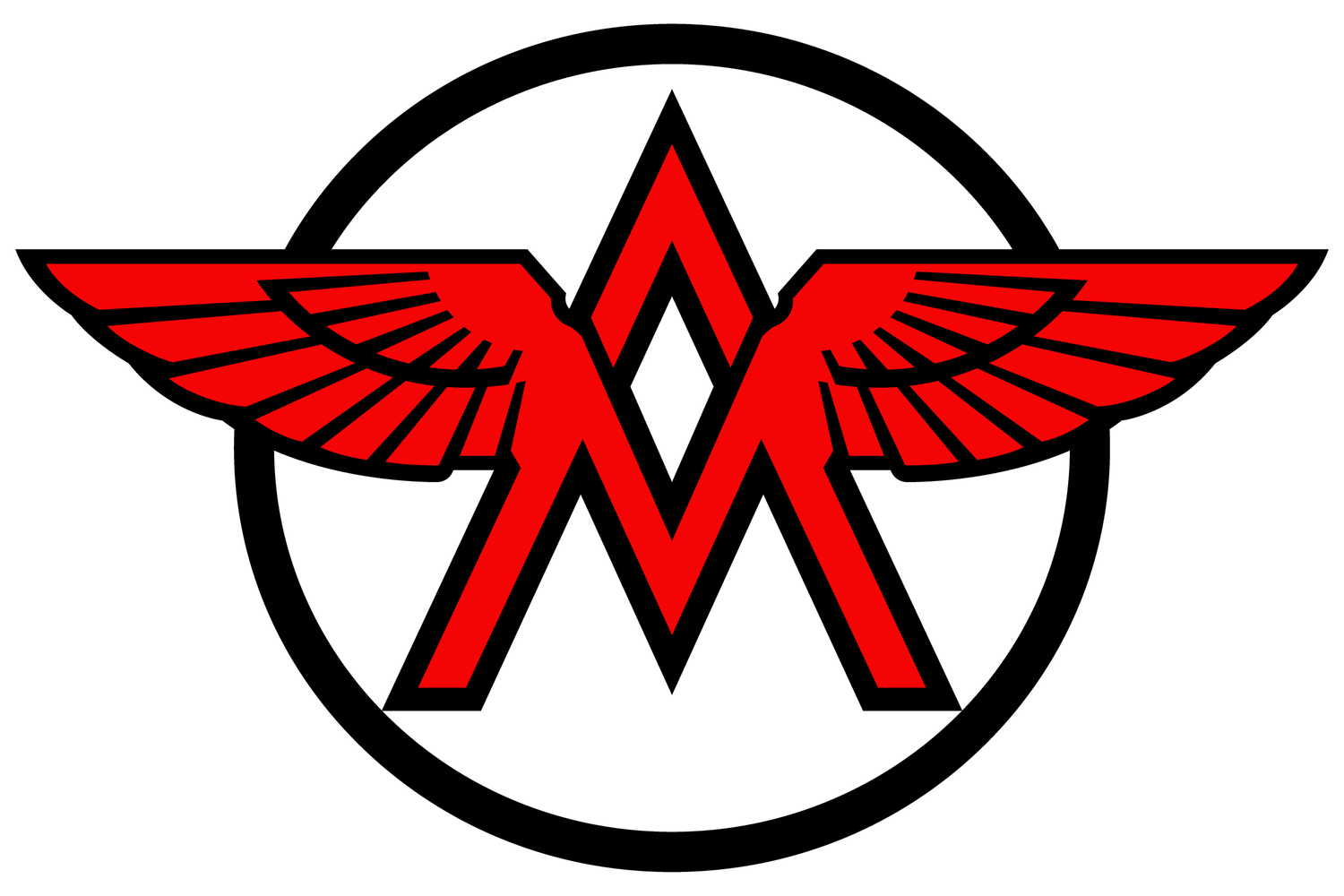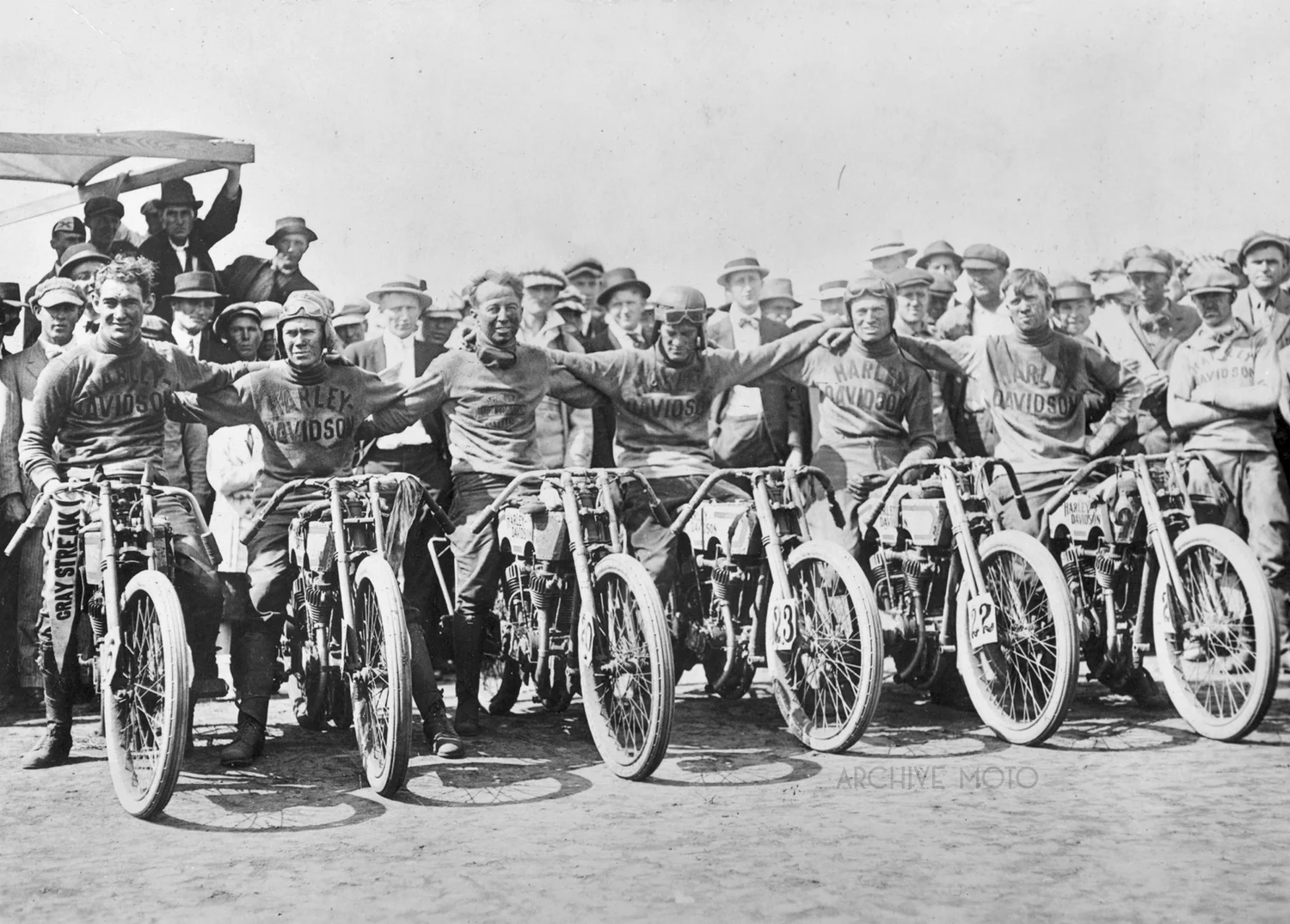Originally from Grand Rapids, ND, Johnny Aikens was the manager at Gus Castle’s Southern Motorcycle Company in Atlanta, Georgia and an avid racer. Aikens had quickly established a reputation as a successful competitor, often claiming perfect scores and first place finishes in regional endurance runs and road races. However, his skills in the saddle were equally matched by his understanding of successful business strategy as he often attributed his accomplishments to the superiority of his machines, the same machines that he just so happened to have for sale at Castle’s Harley-Davidson Southern Branch, where he was the manager.
Stretching it out during morning practice laps in Brooklyn, NY, July 4th, 1916. Eighteen men warming up before the big Independence Day races on the 2 miles of rough sewn boards at the Sheepshead Bay Speedway. Legendary pioneers in American motorcycle racing like Arthur Chappel, Bill Brier, Curley Fredericks, Teddy Carroll, George Sorrenson, Johnny U. Constant, and Harley-Davidson’s brightest star Leslie “Red” Parkhurst were all in this pack, but it was a new machine from the Milwaukee factory which was to be the toast of the day. The latest pure bred racing machine to come from the talented hands of Harley-Davidson’s Bill Ottaway was the new overhead valve v-twin.
Bert Baisden, winner of the 1933 Savannah 200 Mile Championship Road Race, onboard his Harley-Davidson RL ca. 1934.
Mired in the depths of the Great Depression, it was in 1932 that a group of southern motorcycle dealers came together under the name of the Southeastern Motorcycle Dealers Association with a plan to bolster their dwindling sales. The motorcycle industry in America had atrophied since the explosion of manufacturers before WWI, and with the closing of the Excelsior shop in 1931 only Harley-Davidson and Indian remained. In their own bid for driving depression-era sales each of the companies offered rugged and reliable side valve engine platforms and an array of vibrant colors. The sport of professional racing had taken a hit with the country’s economic downturn as well. The golden age of big names stars, top-fuel machines, and thrilling board tracks were gone, having given way to highly specialized and costly Class A competition which was then focused mostly on 1/2 mile dirt track speedway races, near vertical hill climbs, and straight line speed records. However, the gentlemen of the Southeastern Motorcycle Dealers Association had a brilliant idea… get the everyday enthusiast back into the racing game themselves and you would revitalize the marketplace.
The association organized their first event in April of 1932, opting to utilize 3.3 miles of the now two decade-old Grand Prize road circuit in Savannah, Ga. The race was a 200 mile TT style road race for stripped stock machines, and on the day of the big event 13 men lined up in hopes of capturing the glory, and the $500 prize. A local enthusiast, Ralph Edwards, who had already established his reputation for being a skilled competitor crossed the line first in ’32 on board his own Harley-Davidson, and though not quite as successful as the association had hoped for, the idea of organized competition for “owner-racers” would stick. For the 1933 race the date was pushed back to the 4th of July weekend and the entry list grew to 23 competitors. Longtime AMA Secretary E.C. Smith was later quoted as saying that this race in Savannah in would mark the birth of a new class of competition, one which would grow to become the most popular form of the sport for the coming decades, the AMA Class C. Another local racing enthusiast, Bert Baisden claimed the victory and the $500 in 33 onboard his Harley-Davidson. Baisden, seen here onboard his Harley-Davidson RL in this photo from around 1934 was an avid racer, winning championship road races and hill climbs throughout the 1930’s, but as a non-professional it was the advent of Class C competition that allowed him to secure his place in American motorcycle history.
The 200 mile race became an AMA National Championship in 1934 and relocated to a new course at Camp Foster, near Jacksonville, FL. Yet another Savannah native, Bremen Sykes wound out a Harley-Davidson for the win, beating the field of 35 entrants, including his friend Baisden who came in 3rd, and becoming the first AMA National Champion on the books. Shortly after Sykes’ victory Harley-Davidson began running their “Ride a Winner” advertising campaign touting the success of their rugged, reliable, and fast side valve Rl and VL machines. The race was again staged in Jacksonville in 1934, being won for the first time by an Indian ridden by Rody Rodenberg. As Class C competition began to rise in popularity, both Harley-Davidson and Indian realized the potential in this “everyman’s” competition and development quickly focused not more on improving their stock models rather than their competition purebreds, and with factory focus so too came a new breed of professional class of riders. In 1936 the 200 mile National Championship race returned to the road course in Savannah, attracting riders from all over the country. Now a national event with national publicity, the Savannah 200 had grown into a major competition in American motorcycle racing and helped to revitalize a region, an industry, and a sport. Ironman Ed Kretz onboard an Indian bested the 72 entrants at Savannah in 1936, and would go on to repeat his victory at a brand new course the next year, one which would remain a cornerstone of American competition for decades to come… Daytona.
Motorcycle racing in Daytona would go onto become an American institution, as would the legendary men who would compete for Indian, Harley, and an eventual invasion of imported makes. However, it was men like Bert Baisden, the everyman's champion, one of the fore father’s of Class C competition, and events like the Savannah 200 that helped to pull an industry, and a sport from the brink.
Read more about the birth of AMA Class C racing and the many roles in which the Georgia motorcycle culture of the 1930’s had to play in the pages of Georgia Motorcycle History, available now HERE.
This image, though quite poor quality, represents a milestone moment in the history of America’s most beloved motorcycle brand, Harley-Davidson. It was taken back in the summer of 1905 as the young startup venture was just getting its feet underneath itself. Though countless sources, including a rather erroneous documentary series will proclaim many details concerning the origins of the might Harley-Davidson, the truth remains much murkier than many are willing to admit. What is confirmable though is that by June of 1905 there were at least 4 Harley-Davidson motorcycles on the road and in a letter to the local paper Arthur Davidson officially announced that the Harley-Davidson Motor Co. had been formed to “manufacture motors and motor-cycles.” This grainy glimpse into that watershed moment came just the week before that article ran when two of the young company’s best took their newest machine out to the Milwaukee Mile to tests its measure.
On June 2, 1905, co-founder Walter Davidson rolled up to the starting line of the Wisconsin State Fair horse track onboard the latest Harley-Davidson creation, a 27ci loop frame “heavy.” Despite the excessive weight compared to the day's standards, the new Harley kicked the dirt up to the sky and Davidson beat out Henry Zerbel and his underpowered Merkel by a reported 1/8th of a mile. The next day, on June 3rd, the company’s first employee, a proficient engineer named Perry E. Mack took another of the new big bore Harley’s to the Milwaukee Mile. Mack bolted around the oval, coming in first in the 3-mile race clocking nearly 48 mph, setting both a new State and track record of 1 minute 16 seconds, all while beating his boss to boot. Success in Milwaukee field the fire of ambition in Arthur, Walter, and Mack and they set their sites on the big Fourth of July races in Chicago. One month later, on July 4th the motormen from Milwaukee made their way to Chicago’s Garfield Park where a series of high stakes championship races were to be held on the 1/3 mile cement oval. Glenn Curtiss started the event off with an exhibition of his monstrous ‘Hercules” v-twin, covering 5 miles in 5 minutes and 5 seconds, nearly 60 mph on a track in 1905. Walter Davidson then went on to claim victory in the 10-mile open and came in second behind Perry Mack, who averaged a speed of 47 mph in the 15-mile race. However, when Mack was leading the 10-mile championship race a small fox terrier darted out onto the track directly in front of a speeding Perry Mack. The collision was unavoidable, the dog was done in an instant, and Perry Mack was only barely able to stumble his way into the infield before collapsing with a 6-inch gash cut across his forehead.
Mack would eventually recover, and the Davidson boys would continue to test the waters of competition, but for Perry E. Mack his run at Garfield Park would be his last in the sport. He continued his role as an essential asset to the Harley-Davidson Motor Co. until leaving in 1906 to explore his own ideas in motors, motorcycles, and cyclecars, blazing his own trail as a pioneer in OHV engine design associated with brands like Waverley, P.E.M., and Jefferson. Poor quality though it is, this is Perry E. Mack behind the U.S Post Office on Wisconsin Ave in Milwaukee, June 3rd, 1905. This is the company’s first known competition photograph, with what is possibly the second or third Harley-Davidson ever made.
A special thanks to Dick Werner and Herb Wagner for sharing with me their in-depth research on this momentous moment in our history.





